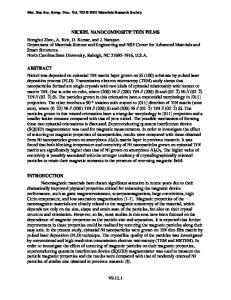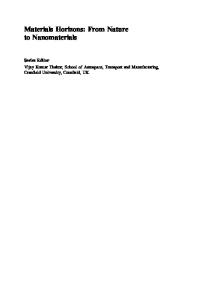Multifunctional, self-assembled oxide nanocomposite thin films and devices
- PDF / 1,254,292 Bytes
- 10 Pages / 585 x 783 pts Page_size
- 82 Downloads / 356 Views
Introduction New multifunctional materials and systems are highly sought after in modern electronics. Strongly correlated oxides are ideal materials for realizing such multifunctional properties because they exhibit a wide range of properties arising from the strong interplay among the structural, electronic, magnetic, and even ionic degrees of freedom.1,2 One highly topical example that has been widely explored is electrically switchable magnetic memory for realizing the sought-after goal of lowpower, nonvolatile random-access memory.3–5 In the absence of single-phase materials exhibiting sizable magnetoelectric coupling effects at room temperature, coupled oxide systems have been widely studied, as discussed in the article in this issue by Hu et al. Heterointerfaces of oxide materials are also important for realizing new physical phenomena.6–8 The most widely known example of this is exhibited by the polar interfaces in LaAlO3/SrTiO3 (LAO/STO) heterostructures. A highly conducting two-dimensional electron gas is formed at the interface between the two insulators,9 which shows great potential for a new class of high-frequency transistors. Many other artificial oxide superlattices have also been studied, and completely unexpected phenomena, including magnetic,10 ferroelectric,11 and ionic12 effects, have been reported.
In parallel with the large range of novel functionalities enabled by high-quality planar heterointerfaces, heteroepitaxial nanocomposite thin films composed of at least one strongly correlated metal oxide coupled with another synergistically selected oxide have emerged as a new thin-film device platform in the past decade.13–17 Such structures offer a promising alternative to conventional planar films for future nanoelectronics needs. In this article, we review recent advances in nanocomposite architectures formed by two epitaxial phases in a film-on-substrate geometry, with a focus on vertically aligned nanocomposites (VANs). First, we introduce different growth mechanisms in various selfassembled nanocomposite films and discuss important factors affecting their morphologies and pillar dimensions. Second, we highlight several key functionalities tailored by the strong coupling between the two phases and the interface effects, including enhanced flux pinning in high-temperature superconductors,18–20 strain-enhanced ferroelectricity and multiferroics,13,21–24 enhanced ferromagnetism,25–27 magnetoresistance,28,29 novel electronic/ionic transport,30–32 and novel coupled dielectric and optical effects.33–35 Finally, we discuss the challenges in designing different nanocomposite structures and related physical properties before proposing future directions.
Wenrui Zhang, Department of Materials Science and Engineering, Texas A&M University, USA; [email protected] Ramamoorthy Ramesh, Department of Materials Science and Engineering and Department of Physics, University of California, Berkeley, USA; and Lawrence Berkeley National Laboratory, USA; [email protected] Judith L. MacManus-Driscoll, Department of Materi
Data Loading...











